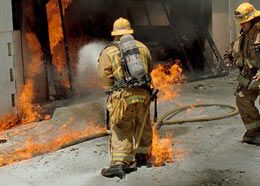 Photo Mike Meadows An L.A. firefighter shows the need for reliable PPE as flames approach his leg. |
NFPA standards covering fire and other emergency service personal protective equipment set comprehensive detailed requirements for their design, testing, performance and documentation.
The certification that comes with them was established to help improve firefighter and emergency responder protection and to ensure the quality of PPE that is available for improved health and safety of fire responders. Recognizing certified products is essential to knowing the manufacturer is making appropriate claims against the NFPA standard and the product is delivering a minimum level of protection.
End users rely on PPE for their health and safety during emergency operations. It is the emergency responder’s expectation that PPE provide the highest possible level of protection along with other qualities that permit the products to be usable under a variety of exposure conditions. The fire service and other emergency response organizations specify products that comply with NFPA standards as these standards set the minimum requirements for product design and performance as established by a balanced consensus process.
The use of standards helps to free the end user from knowing all the details related to the construction and materials used in products. The evidence that PPE meets a specific NFPA standard is found on the product itself in the form of the product label.
The product label contains specific information identifying the product, such as the manufacturer name, contact information, style or model number. Other information on the product label includes the product size, principal materials of construction, cleaning precautions, and a serial number or other means for tracing the product back to its production lot.
Compliance statement
For purposes of certification, the most significant parts of the product label are the compliance statement and the certification organization’s mark. The compliance statement indicates that the specific product meets the requirements of the relevant NFPA standards(s). This language is set in the standard itself and is not supposed to be altered. Language such as “Designed to meet …" or “Meets the relevant portions of …" are not true compliance statements. Only products that meet all requirements of a NFPA standard, including independent third-party certification, can carry this compliance statement. Third-party certification is demonstrated by the appearance of the certification organization’s mark on the product label.
The mark of the certification organization on the product label is testament to the fact that the PPE item has been independently certified. Only product labels with a mark such as those certified by Underwriters Laboratories or the Safety Equipment Institute have met all the rigors of a third-party certification process required by each NFPA product standard.
The certification process specified by each NFPA product standard is by far the most comprehensive and detailed set of requirements that are used for the certification of PPE. This process requires independent testing by the certification organization or its laboratories to establish that the product meets every requirement in the standard. This testing is carried out when the product is first submitted for certification, but is continued for as long as the product is presented as being certified on an annual basis through follow-on testing.
But certification is much more than product testing. Since only a small portion of the actual products can be tested (most product tests are destructive), certification also includes mandatory quality assurance procedures to be used by the PPE manufacturer to ensure that each and every product they make meets the requirements of the standard, not just those samples that are submitted for testing. Not only must manufacturers have in place quality assurance programs that are separately registered to ISO 9001 (a comprehensive quality assurance standard), manufacturing sites are also subject to periodic unannounced audits by the certification organization, where quality practices are checked and samples may be selected for random testing.
The certification organization has the right to withdraw their mark and the listing of the product at any time where the product does not continue to qualify to the requirements of the standard. Products that are certified are “listed” by the certification organization. This means that the certification organization maintains a list of the manufacturers and respective products meeting each standard. One way to check on a product being certified is to go the Web site of the respective certification organization to determine if the particular models or styles of specific PPE are indeed listed as certified against a specific standard.
Accreditation needed
Not any laboratory or organization can be a certification organization. The certification organization labs and their respective laboratories must be accredited to applicable certification and laboratory standards. A laboratory that simply can test a product cannot qualify for all requirements for a certification organization as defined by the NFPA standard.
Certification organizations are obliged to investigate complaints of product performance. If problems with a specific item of PPE arise, end users should notify both the manufacturer and the certification organization. Such notifications are important because it helps to identify possible trends in problems, which may be occurring over a range of products or for a particular style or model. This information can then be used to apply corrections to the product or additional requirements to a particular standard can be proposed to address the issue. Manufacturers are required to maintain logs of customer complaints, which in turn are reviewed by the certification organizations.
As comprehensive as the NFPA certification process is, it is not perfect. Abuses of the process can still happen, whether intentional or unintentional. In particular, there are no organizations that undertake the policing of the entire safety equipment market, such as the Food and Drug Administration does for drugs and medical devices. Legitimate certification organizations will vigorously monitor the proper use of their marks and will generally take steps to ensure that manufacturers, which they certify, comply with the different standards.
However, some manufacturers may take short cuts or misrepresent their products. There have even been circumstances where false certification claims have been made and products that should not comply with standards are represented as meeting an NFPA standard. Sometimes, these misrepresentations take the form of carefully worded statements that imply certification but unless the product is actually certified and listed by a qualified certification organization, it does not meet the standard.
To have confidence that the PPE you select meets NFPA standards, the following steps can be used:
1. Check the product label to see if there is the mark of a certification organization.
2. Contact that certification organization to ensure that the specific style or model you are using is listed and is in fact certified. This may be done online or by directly calling the certification organization. The certification organization will let you know if the specific product is certified.
3. If you cannot readily identify the certification organization or have questions about the way the product is represented, contact the NFPA at 617-770-3000. The NFPA does not enforce certification, but they may be able to answer your questions or at least point you in the right direction to find out if the product is certified.
4. If you find that a product is not certified but is making claims for certification, inform your state attorney general’s office. Misrepresentation of products is an offense that may be prosecutable and warrant action by the state attorney general’s office.
Certification has been established to help improve the firefighter and emergency responder protection and to ensure the quality of PPE that is available for improved health and safety of fire responders. Recognizing certified products is essential to knowing the manufacturer is making appropriate claims against the NFPA standard and the product is delivering a minimum level of protection.
| Discuss this article at FireRescue1 Forums |


